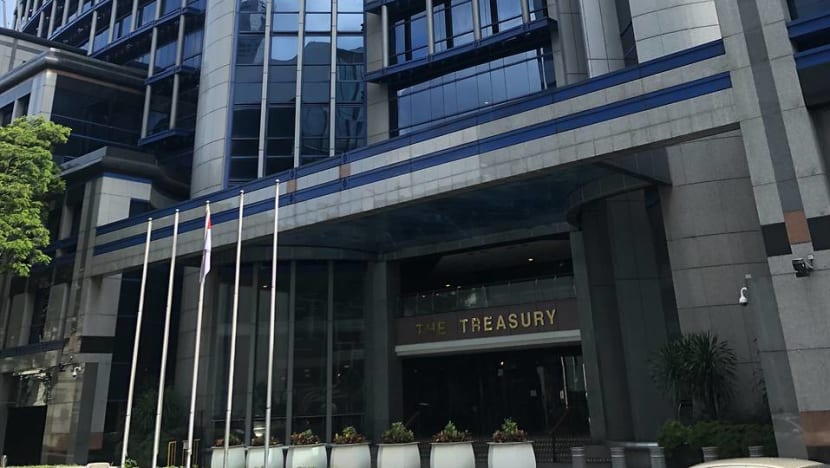CNA Explains: How are political salaries in Singapore calculated?
The next review of salaries paid to Singapore's political appointment holders is targeted for this year.

The Treasury in Singapore, where the Public Service Division is located. (Photo: Wikimedia Commons)
SINGAPORE: A review of the salaries of Singapore's political appointment holders is being targeted for 2023, according to Minister-in-charge of the Public Service Chan Chun Sing.
When the current salary framework was introduced in 2012, Parliament endorsed a White Paper on Salaries for a Capable and Committed Government, recommending that it be reviewed every five years.
The last review, conducted in 2017, did not result in any changes to the salary framework.
CNA looks at how the salary of political appointment holders is calculated, whether any changes were previously recommended, and why they were not taken up.
HOW ARE POLITICAL SALARIES CALCULATED?
Political salaries are benchmarked against private sector salaries.
The benchmark for an entry-level minister, pegged at grade MR4, is based on the median income of the top 1,000 Singaporean income earners, with a 40 per cent discount applied "to reflect the ethos of the public service", according to the Public Service Division (PSD).
The salaries of other political office holders are determined based on their salary ratios to MR4. The salary ratios reflect the roles and responsibilities of the different political appointment holders.
For example, the Prime Minister earns twice the salary of an MR4 minister, according to PSD.
Political appointment holders receive only one pay package regardless of the number of appointments they hold.
WHY IS THE SALARY BENCHMARK DESIGNED THIS WAY?
PSD said that while the first quality the Government looks for in a political appointment holder is a sense of public service, this is "not in itself sufficient to run a country well".
The Government also looks out for other qualities, including "organisational and leadership capabilities, capacity to handle multiple responsibilities, ability to solve problems and take charge in a crisis, and the ability to hold his own with world leaders and further Singapore's interests".
Included in the list of the top 1,000 Singaporean income earners are those in senior management positions, from CEOs to general managers in a range of industries; representatives from financial services, including bankers, asset managers and traders; and professionals, including lawyers, accountants, doctors and engineers.
"Looking at the responsibilities of the jobs that these 1,000 hold, this is a reasonable level that reflects the quality and abilities of people that Singapore seeks to bring in as ministers for continued good government," PSD said.
SO HOW MUCH DOES A MINISTER EARN?
The political salary formula contains the following fixed and variable pay components:
- Fixed component of 13 months
- Annual variable component, typically set at one month
- Individual performance bonus, set at three months for good performance
- National bonus, set at three months if targets are met
If all the boxes are ticked, the political appointment holder could receive an annual salary of 20 months.
A minister may start out at the lower end of the MR4 range with a monthly salary of S$46,750, according to PSD. This works out to an annual salary of S$935,000, of which the fixed component is S$607,750 and the rest is variable.
The monthly salary at the benchmark level is S$55,000, which comes up to an annual salary of S$1.1 million. The fixed component is S$715,000 and the rest is variable.
HOW MUCH DOES THE PRIME MINISTER EARN?
Using the salary ratio, the Prime Minister receives a total annual salary package that is twice the benchmark level of an MR4 minister, or S$2.2 million.
There is no one to decide on the performance bonus for the Prime Minister, so his bonus is based only on the national bonus, said PSD.
The national bonus is based on four socio-economic indicators, weighted equally: The real median income growth rate of the average Singaporean, the real income growth rate of the lowest 20th percentile of Singaporean income earners, the unemployment rate of Singaporeans and the real gross domestic product (GDP) growth rate.
WHAT ABOUT THE PRESIDENT?
The President receives the same monthly salary as the Prime Minister, including the 13th month, as well as the annual variable component but without the performance and national bonuses. This works out to S$1.54 million.
PSD noted that the President is the head of state and has significant custodial powers, but does not set national policies and does not have direct executive responsibility for governing the country unless in relation to his or her custodial role.
WHAT DID THE 2011 SALARY FRAMEWORK REVIEW FIND, AND HOW DID THE GOVERNMENT RESPOND?
Before the 2011 review, the benchmark pool was smaller, at 48 individuals, and it comprised Singaporeans, permanent residents and Malaysians working in Singapore.
Parliament then endorsed the review committee's recommendations to expand the benchmark pool to the current number of 1,000 individuals, and limit it to only Singaporeans working in Singapore.
The new benchmark meant cuts to political salaries. Including the removal of pension, a minister's annual salary dropped 37 per cent to S$1.1 million and the Prime Minister's annual salary fell by 36 per cent.
HOW ABOUT THE 2017 SALARY FRAMEWORK REVIEW?
The 2017 review committee concluded that the salary scheme remained valid, but recommended adjusting salary levels to match the updated benchmark.
It recommended raising the benchmark annual salary of an MR4 minister to S$1.2 million, and for the Government to consider making annual adjustments to keep pace with the market.
However, the Government decided to maintain the current salary structure and level since the scheme remained valid and the economy was still in transition, it said at the time.
Both reviews in 2011 and 2017 were conducted by an independent committee headed by Dr Gerard Ee, who has held appointments including chairman of the National Kidney Foundation and Changi General Hospital, and president of the Institute of Singapore Chartered Accountants.
















